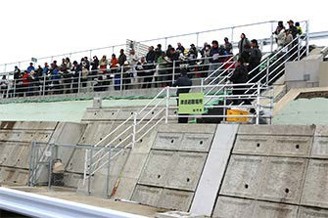
Disaster Management Manual
A manual for practitioners and decision makers!

Disaster Management Manual
A manual for practitioners and decision makers!
Structural and non-structural measures are the powerful measures for disaster mitigation. However, the either of the two measures will not be effective if they would be implemented independently. To enhance the functions provided by both measures, it is important to integrate both measures so that they can function together. But there is another aspect to be considered.
There is some limitation of hazards that can be mitigated by structural measures so that non-structural measures should be taken to cover them. Therefore, it is necessary for residents in the possible disaster area to be aware of disaster risks and to accurately recognize the limitations of structural and non-structural measures. In other words, for disaster mitigation measures to be effective, it is important not only for government-led structural and non-structural measures, but also for local people to be aware of disaster mitigation, to have a common understanding of disaster risks, to share knowledge and roles regarding disaster mitigation measures, and take actions together.
In the field of sociology, there is a concept called social capital. Social capital is a new concept along with Physical Capital and Human Capital 1. According to Wikipedia, social capital is defined as "effective functioning of social groups through interpersonal relationships, a shared sense of identity, a shared understanding, shared norms, shared values, trust, cooperation, and reciprocity 2. Social capital is a measure of the value of resources, both tangible (e.g., public spaces, private property) and intangible (e.g., actors, human capital, people), and the impact that these relationships have on the resources involved in each relationship, and on larger groups." Figure 2.4-1 shows the concept of the three major capitals.

It is said that there is a positive correlation between social capital and civic activities, and it is pointed out that if social capital is rich, participation in civic activities is promoted, and furthermore, social capital is cultivated through the activation of civic activities 3. It is now widely recognized that "self-help, mutual-help, and public-help" are important to enhance community disaster preparedness. Social capital is considered to be a major foundation for the resolution of local issues and revitalization. In other words, social capital is expected to play an important role in disaster mitigation as a regional issue.
Research on social capital in the field of disaster mitigation started around 2008. It has been reported that discussions on disaster prevention in local communities have led to the formation of networks among community members and the development of a sense of mutuality (norms and reciprocity) and trust. There can be found some cases where disaster prevention has activated the "social capital" of local communities 4. In other words, there are cases where disaster reduction has activated the "social capital" of the local community. This shows that the revitalization of local communities and local disaster reduction capacity are inextricably linked. It is desirable that local efforts to promote disaster reduction will activate local community vitalization, which in turn will improve local disaster reduction capacity and road disaster reduction. As a result, it is expected to pave the way for more detailed urban planning in accordance with the actual conditions of each district.

In the area of road disaster management, a steady but budding effort to improve disaster preparedness through dialogue with local communities and raising public awareness has begun. These include: the use of road slopes as tsunami shelters in cooperation with local communities; the participation of citizens in the design of road restoration projects; budding efforts to promote road maintenance and management while raising public awareness; collaborative efforts in school education; and efforts to pass on disaster experience. Figure 2.4-2 5. shows the evacuation drill between highway authorities and local residents. These efforts are still in the process of trial and error, but they are showing steady results.
The synergistic effect of social capital in the field of road disaster management has only just begun. Further development is expected in the future.